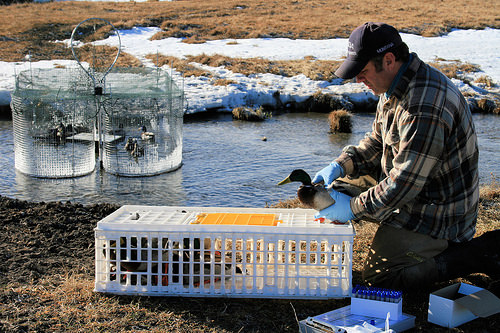On a cold and blustery day, APHIS wildlife disease biologist Jared Hedelius sits in his truck by the Bighorn River in Montana and waits. Although the temperatures outside are well below freezing, the mallards on the river are busy searching for food, oblivious to Jared’s swim-in live trap just a few feet from the shoreline. Soon, enough ducks have entered the trap and Jared leaves his warm truck and heads to the water. He sets up his equipment and begins collecting samples.
Jared is one of 36 wildlife disease biologists in APHIS’ Wildlife Services (WS) program tasked with collecting samples from live and hunter-harvested wild birds for avian influenza testing. Wild migratory waterfowl are a natural reservoir for avian influenza, and these viruses can travel in wild birds without them appearing sick. Highly pathogenic avian influenza was recently found in two commercial premises in Tennessee and, in 2017, low pathogenic avian influenza has also been confirmed in commercial and backyard premises in Wisconsin, Tennessee, Alabama and Kentucky. Although the cause of these cases is not known, it’s a reminder of the need to be vigilant about biosecurity and to maintain a barrier between wild birds and domestic poultry.
“By monitoring the avian influenza strains circulating in wild birds, WS and its partners are able to provide an early warning system to America’s poultry producers,” states Dr. Tom DeLiberto, Assistant Director of WS’ National Wildlife Research Center. “Our experts focus their sampling on waterfowl species and locations where we are most likely to detect avian influenza. This ensures our efforts are as efficient and informative as possible.”
In early January, a sample Jared collected from a hunter-harvested mallard in Fergus County, Montana, tested positive for H5N2 highly pathogenic avian influenza, one of the strains which circulated in North America during the 2014-2015 avian influenza outbreak in domestic poultry. The outbreak affected over 49 million birds and cost approximately $1 billion in damages and control costs.
“Although it is possible for domestic poultry to become infected with avian influenza from direct contact with wild birds, it is more likely that the viruses are spread indirectly to poultry on contaminated feed, clothing and equipment,” notes DeLiberto.
Since 2006, WS has been a leader in a national, multiagency effort to monitor wild birds for highly pathogenic avian influenza. Between July 2015 and March 2016, WS and its partners tested more than 45,000 apparently healthy wild birds for avian influenza in targeted areas throughout the United States. Monitoring is ongoing, with peak sampling periods during fall and winter seasons.
For more information on avian influenza surveillance in wild birds and the latest findings, please visit: www.aphis.usda.gov/animalhealth/defendtheflock.

